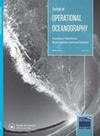北巴西潜流区(1°-11°S)面向特征的区域模拟系统的建立及其在波提瓜尔涡旋成因过程研究中的应用
IF 2.4
3区 地球科学
Q4 METEOROLOGY & ATMOSPHERIC SCIENCES
引用次数: 6
摘要
开发了西赤道大西洋(1°-11°S)面向特征的区域建模系统(FORMS)的关键要素,以便可能应用于业务预报系统以及面向过程的研究。赤道边缘地区以北巴西近地表潜流(NBUC)和西南深西边界流(DWBC)为主。具体来说,我们研究了NBUC地下锋面弯曲的成因,其中心位于约4°S, 36.5°W,称为波提瓜涡(PE)。NBUC和DWBC的特征模型(FMs)首先由观测到的速度数据建立,温度由热风方程计算,盐度由气候学计算。然后为过程研究设置了两个数值实验,(i)一个真实的NBUC + DWBC实验,最大深度为5500 m, (ii)一个只有NBUC的实验,最大深度限制为1500 m。结果表明,仅包含NBUC的速度场可以产生PE,而DWBC诱导的垂直切变似乎对涡旋的斜压特征(垂直范围和强度)起作用。这项研究强调了在洋流和地形相互作用形成永久和/或半永久涡流的世界海洋类似区域,应用FORMS进行业务预报和过程研究的潜力。本文章由计算机程序翻译,如有差异,请以英文原文为准。
Development of a feature-oriented regional modelling system for the North Brazil Undercurrent region (1°–11°S) and its application to a process study on the genesis of the Potiguar Eddy
ABSTRACT Key elements of a Feature-oriented regional modelling system (FORMS) in the Western Equatorial Atlantic (1°–11°S) are developed for possible application in an operational forecast system as well as in process-oriented studies. This equatorial margin region is dominated by the northwestward flowing near surface North Brazil Undercurrent (NBUC) and the southeastward Deep Western Boundary Current (DWBC). Specifically, we investigate the genesis of a subsurface frontal meander of the NBUC, centred at about 4°S, 36.5°W, called the Potiguar Eddy (PE). The Feature Models (FMs) of NBUC and DWBC are first developed from observed velocity data, with temperature calculated through the thermal wind equation, and salinity from climatology. Two numerical experiments were then set up for the process study, (i) a realistic NBUC + DWBC experiment, with maximum depth of 5500 m, and (ii) a NBUC-only experiment, with maximum depth limited to 1500 m. Results conclude that the PE can be generated by a velocity field containing only the NBUC, and the DWBC – induced vertical shear seems to play a part on the eddy’s baroclinic characteristics (vertical extent and strength). This study highlights the potential of applicability of FORMS for operational forecasts and for process studies in similar regions of the world ocean where currents and topography interact to create permanent and/or semi-permanent eddies.
求助全文
通过发布文献求助,成功后即可免费获取论文全文。
去求助
来源期刊
CiteScore
7.50
自引率
9.70%
发文量
8
审稿时长
>12 weeks
期刊介绍:
The Journal of Operational Oceanography will publish papers which examine the role of oceanography in contributing to the fields of: Numerical Weather Prediction; Development of Climatologies; Implications of Ocean Change; Ocean and Climate Forecasting; Ocean Observing Technologies; Eutrophication; Climate Assessment; Shoreline Change; Marine and Sea State Prediction; Model Development and Validation; Coastal Flooding; Reducing Public Health Risks; Short-Range Ocean Forecasting; Forces on Structures; Ocean Policy; Protecting and Restoring Ecosystem health; Controlling and Mitigating Natural Hazards; Safe and Efficient Marine Operations

 求助内容:
求助内容: 应助结果提醒方式:
应助结果提醒方式:


